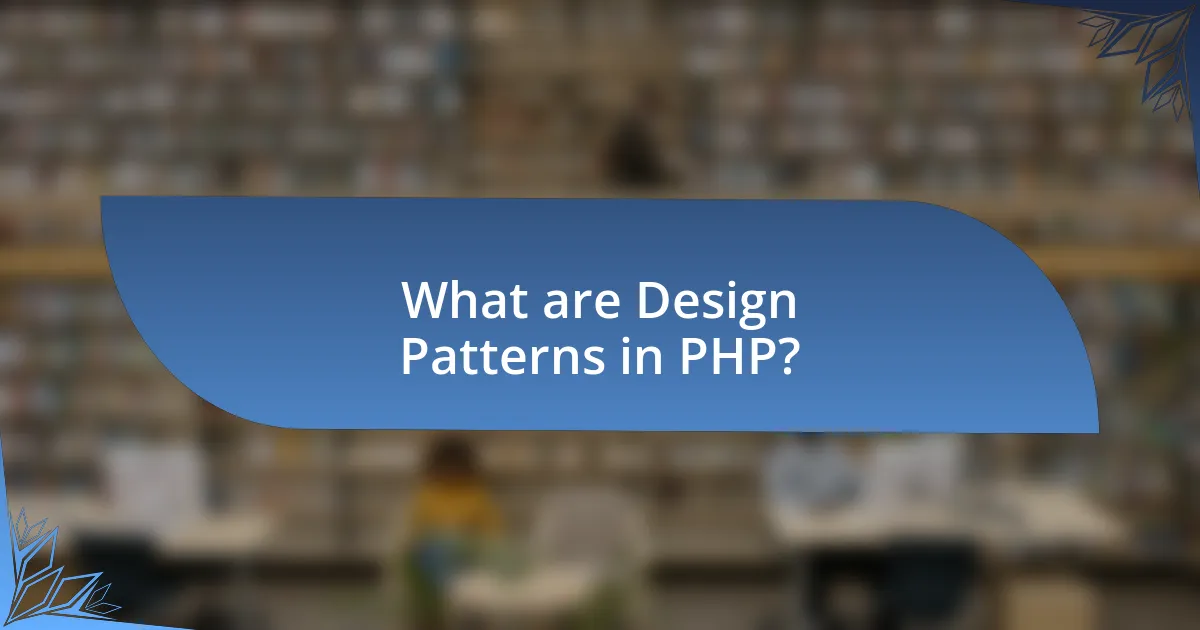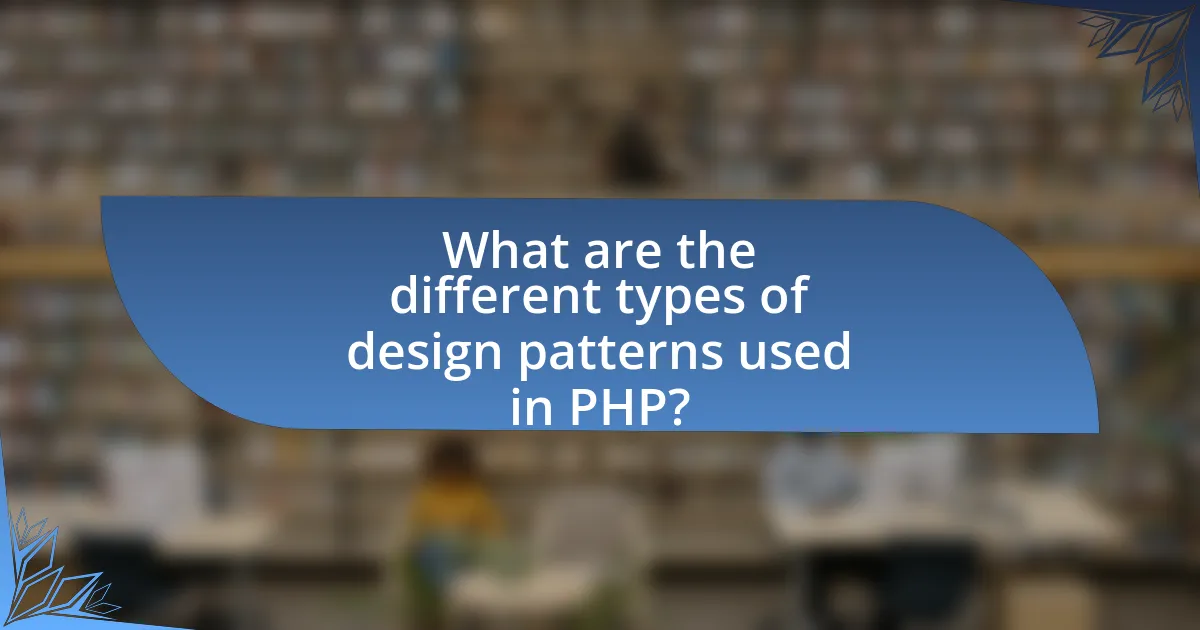Design patterns in PHP are established solutions to common software design challenges, enhancing code organization, scalability, and maintainability. This article explores various design patterns, including Creational, Structural, and Behavioral patterns, and their practical applications in PHP development. Key patterns such as Singleton, Factory, and Observer are examined for their roles in improving code reusability and facilitating collaboration among developers. Additionally, the article discusses best practices for implementing these patterns, common pitfalls to avoid, and how to select the appropriate design pattern based on specific project needs.

What are Design Patterns in PHP?
Design patterns in PHP are standardized solutions to common software design problems that arise during application development. They provide a template for how to solve issues related to code organization, scalability, and maintainability. For instance, the Singleton pattern ensures that a class has only one instance and provides a global point of access to it, which is particularly useful in managing shared resources. The use of design patterns in PHP enhances code reusability and facilitates easier collaboration among developers, as these patterns are widely recognized and understood within the programming community.
How do design patterns enhance PHP development?
Design patterns enhance PHP development by providing proven solutions to common software design problems, which improves code maintainability and scalability. By utilizing design patterns, developers can create a consistent architecture that facilitates easier collaboration and reduces the likelihood of errors. For instance, the Singleton pattern ensures that a class has only one instance, which is particularly useful for managing shared resources like database connections. This approach not only streamlines resource management but also adheres to the DRY (Don’t Repeat Yourself) principle, leading to cleaner and more efficient code.
What are the key characteristics of design patterns?
Design patterns are reusable solutions to common problems in software design, characterized by their generality, reusability, and clarity. They provide a template for solving specific design issues, allowing developers to communicate effectively about design concepts. The key characteristics include abstraction, which simplifies complex systems; encapsulation, which hides implementation details; and modularity, which promotes separation of concerns. These characteristics enable easier maintenance and scalability of software systems, as evidenced by the widespread adoption of design patterns in various programming languages, including PHP, where they enhance code organization and reduce redundancy.
How do design patterns improve code maintainability?
Design patterns improve code maintainability by providing standardized solutions to common problems, which enhances code readability and reduces complexity. When developers use established design patterns, they create a shared vocabulary that facilitates easier understanding and collaboration among team members. For instance, the Singleton pattern ensures that a class has only one instance, simplifying resource management and reducing the risk of errors. Additionally, patterns like MVC (Model-View-Controller) separate concerns, allowing developers to modify one aspect of the application without affecting others, thus streamlining updates and debugging processes. This structured approach leads to fewer bugs and a more organized codebase, ultimately making maintenance more efficient.
Why are design patterns important for PHP developers?
Design patterns are important for PHP developers because they provide proven solutions to common software design problems, enhancing code maintainability and scalability. By utilizing design patterns, PHP developers can create more organized and efficient code structures, which facilitate easier collaboration and reduce the likelihood of bugs. For instance, the Singleton pattern ensures that a class has only one instance, which is crucial for managing shared resources effectively. This approach not only streamlines the development process but also aligns with best practices in software engineering, as evidenced by the widespread adoption of design patterns in various programming communities.
What common problems do design patterns solve?
Design patterns solve common problems in software design, such as code reusability, maintainability, and scalability. They provide standardized solutions to recurring design issues, enabling developers to communicate more effectively and reduce the complexity of their code. For instance, the Singleton pattern addresses the problem of ensuring a class has only one instance while providing a global access point to that instance. Similarly, the Observer pattern facilitates a subscription mechanism to allow multiple objects to listen and react to events or changes in another object, promoting loose coupling. These patterns are widely recognized in software engineering, as evidenced by the “Gang of Four” book, which categorizes 23 foundational design patterns that address these prevalent challenges in object-oriented programming.
How do design patterns facilitate communication among developers?
Design patterns facilitate communication among developers by providing a common vocabulary and standardized solutions to recurring problems in software design. This shared language enables developers to discuss complex concepts more easily, reducing misunderstandings and improving collaboration. For instance, when developers refer to the “Observer” pattern, they immediately convey a specific structure and behavior, allowing for efficient discussions about implementation and integration. Research indicates that using design patterns can enhance team productivity by up to 30%, as they streamline the development process and foster clearer communication among team members.

What are the different types of design patterns used in PHP?
The different types of design patterns used in PHP include Creational, Structural, and Behavioral patterns. Creational patterns, such as Singleton and Factory, focus on object creation mechanisms, ensuring that the system is independent of how its objects are created, composed, and represented. Structural patterns, like Adapter and Composite, deal with object composition, helping to define relationships between entities. Behavioral patterns, including Observer and Strategy, emphasize communication between objects, defining how they interact and delegate responsibilities. These classifications are widely recognized in software engineering, as outlined in the “Design Patterns: Elements of Reusable Object-Oriented Software” by Erich Gamma et al., which serves as a foundational text in the field.
What are the categories of design patterns?
Design patterns are categorized into three main types: creational, structural, and behavioral. Creational patterns focus on object creation mechanisms, optimizing the process of instantiation. Structural patterns deal with object composition, ensuring that if one part of a system changes, the entire system doesn’t need to do the same. Behavioral patterns emphasize communication between objects, defining how they interact and distribute responsibilities. These categories help developers choose the appropriate design pattern based on the specific problem they are addressing in software development.
What are creational design patterns and how are they used?
Creational design patterns are design patterns that focus on object creation mechanisms, aiming to create objects in a manner suitable to the situation. These patterns provide solutions to instantiate objects in a flexible and efficient way, often abstracting the instantiation process to enhance code maintainability and scalability. For example, the Singleton pattern ensures a class has only one instance and provides a global point of access to it, which is useful in scenarios where a single instance is required to coordinate actions across the system. Other examples include the Factory Method, which defines an interface for creating an object but allows subclasses to alter the type of objects that will be created, and the Abstract Factory, which provides an interface for creating families of related or dependent objects without specifying their concrete classes. These patterns are widely used in PHP to manage object creation, improve code organization, and facilitate testing and maintenance.
What are structural design patterns and their applications?
Structural design patterns are design patterns that focus on how objects and classes are composed to form larger structures while ensuring flexibility and efficiency. These patterns facilitate the organization of code by defining clear relationships between entities, which can enhance code reusability and maintainability. Common applications of structural design patterns include the Adapter pattern, which allows incompatible interfaces to work together; the Composite pattern, which enables clients to treat individual objects and compositions uniformly; and the Decorator pattern, which adds responsibilities to objects dynamically. These patterns are widely used in software development to simplify complex systems and improve code organization, particularly in object-oriented programming languages like PHP.
What are behavioral design patterns and why are they significant?
Behavioral design patterns are design patterns that focus on the interaction and responsibility of objects, defining how they communicate and collaborate to achieve specific tasks. These patterns are significant because they enhance flexibility and efficiency in software design by promoting loose coupling and improving code maintainability. For instance, the Observer pattern allows a subject to notify multiple observers about state changes, facilitating a dynamic and responsive system. This adaptability is crucial in complex applications where components must work together seamlessly, ultimately leading to more robust and scalable software solutions.
How can specific design patterns be implemented in PHP?
Specific design patterns can be implemented in PHP by utilizing classes and interfaces that encapsulate the desired behavior. For example, the Singleton pattern can be implemented by creating a class with a private constructor and a static method that returns the single instance of the class. This ensures that only one instance exists throughout the application.
Another example is the Factory pattern, which can be implemented by defining a factory class with a method that creates and returns objects based on input parameters. This allows for the creation of objects without specifying the exact class of the object that will be created.
The Observer pattern can be implemented by creating a subject class that maintains a list of observers and notifies them of state changes. Observers implement a specific interface to receive updates from the subject.
These implementations are supported by PHP’s object-oriented features, such as inheritance and interfaces, which facilitate the design pattern structure and behavior.
What is the Singleton pattern and how is it implemented?
The Singleton pattern is a design pattern that restricts a class to a single instance and provides a global point of access to that instance. This pattern is implemented by creating a private static variable to hold the instance, a private constructor to prevent direct instantiation, and a public static method that returns the instance, creating it if it does not already exist. For example, in PHP, the implementation would look like this:
class Singleton {
private static $instance = null;
private function __construct() {}
public static function getInstance() {
if (self::$instance === null) {
self::$instance = new Singleton();
}
return self::$instance;
}
}
This implementation ensures that only one instance of the Singleton class can exist, thus fulfilling the pattern’s purpose.
How does the Factory pattern work in PHP?
The Factory pattern in PHP creates objects without specifying the exact class of the object that will be created. This design pattern defines an interface for creating an object but allows subclasses to alter the type of objects that will be created. In practice, a Factory class contains a method that returns an instance of a specific class based on provided parameters, promoting loose coupling and adherence to the Open/Closed Principle. For example, if a Factory method receives a string indicating the type of product, it can instantiate and return the corresponding product class, enabling easier maintenance and scalability of the code.
What is the Observer pattern and how can it be applied?
The Observer pattern is a behavioral design pattern that defines a one-to-many dependency between objects, allowing multiple observers to be notified of state changes in a subject. This pattern can be applied in scenarios such as event handling systems, where a subject (like a data model) notifies various observers (like user interface components) when its state changes, ensuring that all dependent components are updated accordingly. For example, in a PHP application, the Observer pattern can be implemented using interfaces and classes, where the subject maintains a list of observers and calls their update methods when changes occur, facilitating a decoupled architecture that enhances maintainability and scalability.

What are practical examples of implementing design patterns in PHP?
Practical examples of implementing design patterns in PHP include the Singleton pattern, which ensures a class has only one instance and provides a global point of access to it, commonly used for database connections. Another example is the Factory pattern, which creates objects without specifying the exact class of object that will be created, often utilized in scenarios where the system needs to be independent of how its objects are created. The Observer pattern is also prevalent, allowing a subject to notify multiple observers about state changes, frequently applied in event handling systems. Each of these patterns enhances code maintainability and scalability, demonstrating their effectiveness in real-world PHP applications.
How can the Singleton pattern be practically applied in a PHP project?
The Singleton pattern can be practically applied in a PHP project by ensuring that a class has only one instance and providing a global point of access to that instance. This is achieved by defining a private static variable to hold the instance and a private constructor to prevent direct instantiation. The class then includes a public static method that checks if the instance already exists; if not, it creates one and returns it. For example, a database connection class can utilize the Singleton pattern to maintain a single connection throughout the application, reducing resource consumption and ensuring consistent access to the database. This approach is validated by the fact that many frameworks, such as Laravel, implement similar patterns to manage shared resources efficiently.
What are the steps to implement the Singleton pattern in PHP?
To implement the Singleton pattern in PHP, follow these steps:
- Create a private static variable to hold the single instance of the class.
- Define a private constructor to prevent direct instantiation from outside the class.
- Implement a public static method that returns the instance of the class, creating it if it does not already exist.
This approach ensures that only one instance of the class can be created, adhering to the Singleton pattern’s principles. The private constructor prevents multiple instances, while the static method controls access to the instance, ensuring it is created only when needed.
What are the potential pitfalls of using the Singleton pattern?
The potential pitfalls of using the Singleton pattern include issues with global state, difficulty in testing, and challenges in extending functionality. The Singleton pattern creates a single instance of a class, which can lead to unintended side effects when multiple parts of a program rely on that instance, resulting in tightly coupled code. This tight coupling makes unit testing difficult, as it becomes challenging to isolate the Singleton from other components. Additionally, if the Singleton needs to be extended or modified, it can introduce complexity and violate the Open/Closed Principle, which states that software entities should be open for extension but closed for modification. These pitfalls highlight the need for careful consideration when implementing the Singleton pattern in software design.
How can the Factory pattern be utilized in real-world applications?
The Factory pattern can be utilized in real-world applications by providing a way to create objects without specifying the exact class of the object that will be created. This pattern is particularly useful in scenarios where a system needs to be independent of how its objects are created, composed, and represented. For example, in a PHP application that handles different types of user notifications (like email, SMS, or push notifications), the Factory pattern allows the application to instantiate the appropriate notification class based on user preferences without altering the core logic of the application. This promotes code reusability and scalability, as new notification types can be added with minimal changes to existing code.
What are the advantages of using the Factory pattern in PHP?
The advantages of using the Factory pattern in PHP include improved code organization, enhanced flexibility, and easier maintenance. This design pattern allows developers to create objects without specifying the exact class of the object that will be created, promoting loose coupling. By centralizing object creation, the Factory pattern simplifies the addition of new classes and modifications to existing ones, as changes can be made in one location rather than throughout the codebase. Additionally, it facilitates testing by allowing the use of mock objects, which can be easily substituted during unit tests. These benefits contribute to cleaner, more manageable code in PHP applications.
How does the Factory pattern improve code flexibility?
The Factory pattern improves code flexibility by decoupling the instantiation of objects from their usage. This design pattern allows a system to create objects without specifying the exact class of the object that will be created, enabling easier modifications and extensions. For instance, if a new class is added, only the factory needs to be updated, rather than every part of the code that creates instances of that class. This reduces dependencies and enhances maintainability, as demonstrated in various software engineering practices where the introduction of new features requires minimal changes to existing code.
What are best practices for implementing design patterns in PHP?
Best practices for implementing design patterns in PHP include understanding the specific problem each pattern addresses, ensuring code readability and maintainability, and adhering to the principles of SOLID design. Understanding the problem allows developers to choose the most suitable pattern, while readability and maintainability facilitate easier collaboration and future modifications. Adhering to SOLID principles—Single Responsibility, Open/Closed, Liskov Substitution, Interface Segregation, and Dependency Inversion—ensures that the design patterns are implemented in a way that promotes flexibility and reduces the risk of bugs. These practices lead to more robust and scalable applications, as evidenced by the widespread adoption of design patterns in successful PHP frameworks like Laravel and Symfony, which emphasize these principles in their architecture.
How can developers choose the right design pattern for their needs?
Developers can choose the right design pattern for their needs by analyzing the specific problem they aim to solve and matching it with the characteristics of available design patterns. For instance, if a developer needs to create a system that requires flexibility and easy maintenance, they might consider using the Strategy pattern, which allows for interchangeable algorithms. Additionally, understanding the context of the application, such as whether it requires scalability or performance optimization, can guide the selection process. Research indicates that design patterns can improve code maintainability by up to 30%, as shown in studies like “Design Patterns: Elements of Reusable Object-Oriented Software” by Gamma et al., which highlights the effectiveness of design patterns in software development.
What common mistakes should be avoided when using design patterns?
Common mistakes to avoid when using design patterns include over-engineering, misapplying patterns, and neglecting context. Over-engineering occurs when developers implement complex patterns for simple problems, leading to unnecessary complexity. Misapplying patterns happens when a pattern is used inappropriately, such as using a Singleton pattern when multiple instances are needed, which can hinder scalability. Neglecting context involves ignoring the specific requirements of a project, resulting in patterns that do not fit the problem at hand. These mistakes can lead to inefficient code and increased maintenance costs.


